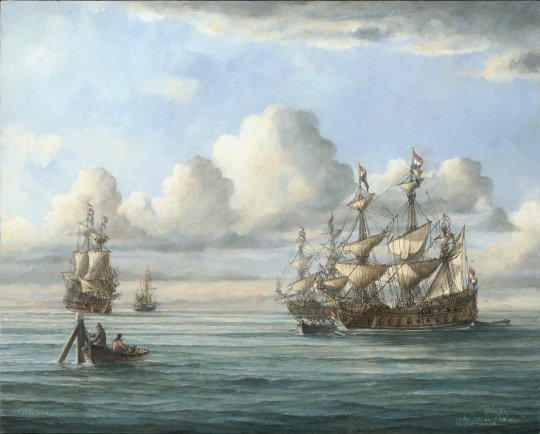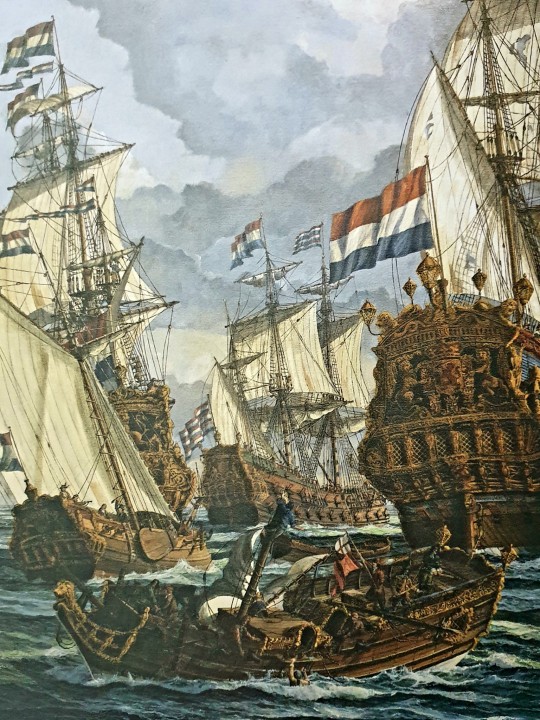#jan de quelery
Text

The Battle of Texel 1673 by Jan de Quelery
#battle of texel#battle of kijkduin#age of sail#art#jan de quelery#netherlands#england#michiel de ruyter#prince rupert#france#dutch republic#dutch#english#french#fleets#navy#royal navy#warship#warships#naval battle#naval warfare#history#europe#european#third anglo dutch war#franco dutch war#north sea#texel#royal prince#kijkduin
46 notes
·
View notes
Text

The “Gouden Leeuw “ and “Zeven Provinciën” in front of Den Oever , Wieringen around 1670, by Jan de Quelery (1957-)
148 notes
·
View notes
Text

Breaking sky, painted with a magnifying glass by Jan de Quelery (1957-)
65 notes
·
View notes
Text

The Battle of Kijduin/Texel 1673, by Jan de Quelery (1957-)
#naval art#battle of kijduin#also known as battle of texel#17th century#dutch vs. english and french ships#age of sail
234 notes
·
View notes
Text

The clipper ship Talus and pilot cutter Mascotte, by Jan de Quelery (1957-)
63 notes
·
View notes
Text

The ship "Liefde" [ Love] , the first ship from Amdiral Michiel de Ruyter, 1662, by Jan de Quelery (1957-)
67 notes
·
View notes
Text

Ships becalmed - With the Dutch “Walcheren “ on the left and the “Huis van Zwieten” [ right] build in 1653, by Jan de Quelery (1957-)
52 notes
·
View notes
Text

A Dutch ship of line in progress, by Jan de Quelery, 2020
52 notes
·
View notes
Text

The Gouda, 72 guns, 1665, by Jan de Quelery (1957-)
86 notes
·
View notes
Text

The Battle of Augusta 22. April 1676, by Jan de Quelery (1957-)
The French fleet consisted of 29 ships of the line, 5 frigates and 8 fireships commanded by Abraham Duquesne. The Dutch-Spanish fleet was composed of 27 ships of the line (17 Dutch-10 Spanish) and 5 fireships, commanded by Lieutenant Admiral General Michiel de Ruyter.
It was a short but fierce naval battle. Neither side lost a ship, but many were killed and wounded, especially on the Dutch side. The battle ended abruptly. The Dutch commander Michiel de Ruyter was seriously injured. When the French admiral Abraham Duquesne learned of this, he decided to withdraw his fleet, out of respect for the legendary naval hero. As a result, the battle ended in a draw.
Michiel de Ruyter died a week later from his injuries
38 notes
·
View notes
Text

The Gouda, 72- guns at Sunset 1666 , by Jan de Quelery
55 notes
·
View notes
Text

Breaking Sky, by Jan de Quelery
44 notes
·
View notes
Text

The Geloof was a dutch third rate, ship of the line and was commanded by Pieter Salmonsz, 1665, she took part in several Battles and was last mentioned 1674, by Jan de Quelery
29 notes
·
View notes
Text

Dutch Admiral flagships in front of Vlissingen 1667, by Jan de Quelery (1957-)
From left to right ; "Walcheren", "Zierikzee" and the ship "Zeven Provinciën"
#naval art#admiral ships#walcheren#zierikzee#zeven provinciën#17th century#dutch flagships#ships of the line#age of sail
39 notes
·
View notes
Text

The Four Days Battle, 11- 14 June 1666 ( Detail) by Jan de Quelery
A Dutch states yacht in the wake of the Zeven Provincien ( Seven Provinces) on her starboard bow is the stern of the Gouden Leeuw ( Golden Lion). In the middle is a third rate and in the foreground a heavily damaged states yacht.
63 notes
·
View notes
Photo

Detail of HMS Royal Charles, 80-guns, first rate, ship-of-the-line, at the raid on the Medway 1667, by Jan de Quelery (1957-)
Royal Charles was an 80-gun first-rate three-decker ship of the line of the English Navy, and was launched at Woolwich Dockyard in 1655. She was originally called Naseby, named in honour of Sir Thomas Fairfax's decisive 1645 victory over the Royalist forces during the English Civil Wars. She was ordered in 1654 as one of a programme of four second rates, intended to carry 60 guns each. However, she was altered during construction to mount a complete battery of guns along the upper deck (compared with the partial battery on this deck of her intended sisters, on which there were no gunports in the waist along this deck), and so was reclassed as a first rate.
In 1667 the English national pride was severely damaged during the raid in the Medway, when the Dutch fleet entered the Thames and the Medway, captured the Royal Charles and with great skill took it to Hellevoetsluis in the Netherlands. The Dutch did not put her in their service because she had too much draught to be generally used on the Dutch coast. It served as a tourist attraction until it was stopped by Charles II due to protests. In 1673 she was auctioned for being broken up.
285 notes
·
View notes